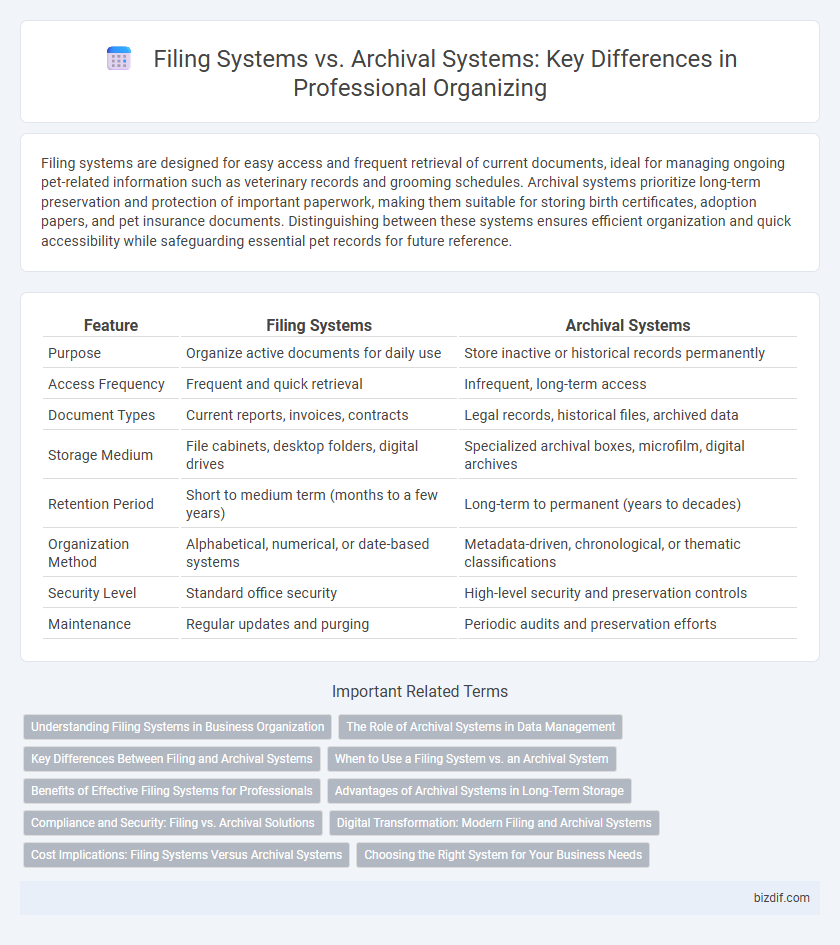Filing systems are designed for easy access and frequent retrieval of current documents, ideal for managing ongoing pet-related information such as veterinary records and grooming schedules. Archival systems prioritize long-term preservation and protection of important paperwork, making them suitable for storing birth certificates, adoption papers, and pet insurance documents. Distinguishing between these systems ensures efficient organization and quick accessibility while safeguarding essential pet records for future reference.
Table of Comparison
| Feature | Filing Systems | Archival Systems |
|---|---|---|
| Purpose | Organize active documents for daily use | Store inactive or historical records permanently |
| Access Frequency | Frequent and quick retrieval | Infrequent, long-term access |
| Document Types | Current reports, invoices, contracts | Legal records, historical files, archived data |
| Storage Medium | File cabinets, desktop folders, digital drives | Specialized archival boxes, microfilm, digital archives |
| Retention Period | Short to medium term (months to a few years) | Long-term to permanent (years to decades) |
| Organization Method | Alphabetical, numerical, or date-based systems | Metadata-driven, chronological, or thematic classifications |
| Security Level | Standard office security | High-level security and preservation controls |
| Maintenance | Regular updates and purging | Periodic audits and preservation efforts |
Understanding Filing Systems in Business Organization
Filing systems in business organization prioritize easy access and frequent retrieval of current documents, categorizing files by client names, dates, or project types to enhance operational efficiency. Archival systems focus on long-term preservation of inactive records, often using specialized storage and labeling methods to ensure documents remain intact for legal or historical reference. Understanding these distinctions helps businesses implement effective information management strategies that balance daily accessibility with secure, organized storage of important historical data.
The Role of Archival Systems in Data Management
Archival systems play a crucial role in professional organizing by securely preserving long-term records and important documents, ensuring easy retrieval and compliance with legal requirements. These systems differ from filing systems by focusing on the preservation, authenticity, and integrity of data over extended periods, often incorporating metadata and version control for improved management. Implementing effective archival systems enhances data governance and supports organizational continuity in managing both digital and physical records.
Key Differences Between Filing and Archival Systems
Filing systems are designed for frequent access and easy retrieval of active documents, prioritizing organization and categorization for current use. Archival systems focus on long-term preservation, ensuring documents are stored securely for historical reference or legal compliance with minimal handling. Key differences include accessibility frequency, storage duration, and the degree of document preservation and protection.
When to Use a Filing System vs. an Archival System
Filing systems are ideal for managing active documents that require frequent access and quick retrieval, such as current projects, client records, and ongoing correspondence. Archival systems are best suited for long-term storage of inactive records, legal documents, or historical data that must be preserved but rarely referenced. Choosing between a filing system versus an archival system depends on the document's usage frequency, retention period, and compliance requirements.
Benefits of Effective Filing Systems for Professionals
Effective filing systems streamline document retrieval, reducing time spent searching for important files and enhancing productivity in professional environments. They ensure consistent organization and categorization of active documents, which supports daily workflows and immediate access to essential information. Maintaining a well-structured filing system prevents misplacement and enables quick update management, contrasting with archival systems designed primarily for long-term storage and historical record keeping.
Advantages of Archival Systems in Long-Term Storage
Archival systems offer superior durability and protection for documents, utilizing acid-free materials and climate-controlled environments to prevent deterioration over time. These systems facilitate easy retrieval through detailed cataloging and metadata, enhancing accessibility while preserving the integrity of records. Unlike traditional filing systems, archival storage is specifically designed to support legal, historical, and compliance requirements for long-term document preservation.
Compliance and Security: Filing vs. Archival Solutions
Filing systems prioritize quick access and organization for frequently used documents, while archival systems focus on long-term storage with enhanced compliance and security measures. Archival solutions implement strict metadata tagging, encryption, and retention policies to ensure document integrity and legal compliance over extended periods. Filing systems may lack these robust security features, making them less suitable for sensitive or regulatory-bound records.
Digital Transformation: Modern Filing and Archival Systems
Digital transformation revolutionizes professional organizing by integrating modern filing and archival systems that prioritize cloud storage, metadata tagging, and AI-driven search capabilities. Digital filing systems enable real-time document access, collaboration, and automated categorization, enhancing productivity and reducing physical clutter. Archival systems focus on secure, long-term preservation of digital records using blockchain technology and encryption to ensure data integrity and compliance.
Cost Implications: Filing Systems Versus Archival Systems
Filing systems typically offer lower upfront costs due to their simpler design and ease of use, making them suitable for daily document access and organization. Archival systems, while more expensive initially because of specialized storage materials and climate control requirements, provide long-term preservation benefits that reduce the risk of document degradation and costly data loss. Businesses must weigh the cost-efficiency of filing systems for active use against the higher investment in archival solutions for secure, long-term document retention.
Choosing the Right System for Your Business Needs
Selecting the right system between filing and archival depends on your business's information access and retention requirements. Filing systems prioritize quick retrieval and frequent updates of active documents, ideal for daily operations and client records. Archival systems focus on long-term storage and preservation of records that are infrequently accessed but must be securely kept for compliance or historical reference.
filing systems vs archival systems Infographic

 bizdif.com
bizdif.com